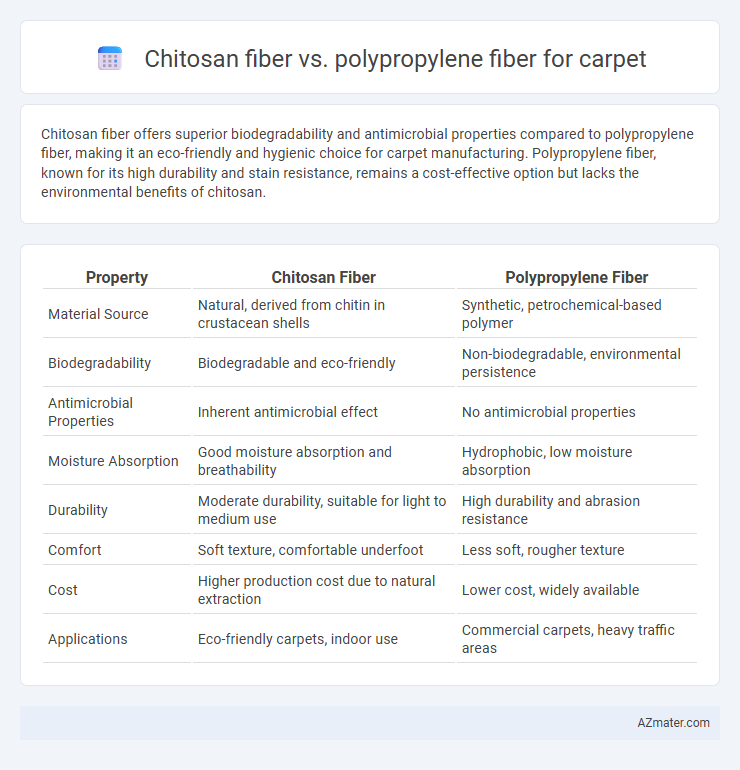Chitosan fiber offers superior biodegradability and antimicrobial properties compared to polypropylene fiber, making it an eco-friendly and hygienic choice for carpet manufacturing. Polypropylene fiber, known for its high durability and stain resistance, remains a cost-effective option but lacks the environmental benefits of chitosan.
Table of Comparison
| Property | Chitosan Fiber | Polypropylene Fiber |
|---|---|---|
| Material Source | Natural, derived from chitin in crustacean shells | Synthetic, petrochemical-based polymer |
| Biodegradability | Biodegradable and eco-friendly | Non-biodegradable, environmental persistence |
| Antimicrobial Properties | Inherent antimicrobial effect | No antimicrobial properties |
| Moisture Absorption | Good moisture absorption and breathability | Hydrophobic, low moisture absorption |
| Durability | Moderate durability, suitable for light to medium use | High durability and abrasion resistance |
| Comfort | Soft texture, comfortable underfoot | Less soft, rougher texture |
| Cost | Higher production cost due to natural extraction | Lower cost, widely available |
| Applications | Eco-friendly carpets, indoor use | Commercial carpets, heavy traffic areas |
Introduction to Chitosan and Polypropylene Fibers
Chitosan fiber, derived from chitin found in crustacean shells, offers biodegradability, antimicrobial properties, and enhanced moisture management, making it an eco-friendly choice for carpet manufacturing. Polypropylene fiber, a synthetic polymer, is known for its durability, stain resistance, and cost-effectiveness, commonly used in commercial and residential carpeting. Both fibers provide unique benefits, with chitosan emphasizing sustainability and antimicrobial activity, while polypropylene excels in strength and affordability.
Composition and Manufacturing Processes
Chitosan fiber is derived from chitin, a natural polymer found in crustacean shells, and undergoes deacetylation followed by spinning to form durable fibers, emphasizing biodegradability and antimicrobial properties. In contrast, polypropylene fiber is a synthetic polymer produced through the polymerization of propylene monomers using processes like melt spinning, resulting in lightweight, hydrophobic fibers favored for stain resistance and durability. The natural origin and biodegradable composition of chitosan fiber contrast with the petrochemical-based, non-biodegradable polypropylene fiber, influencing their environmental impact and functional applications in carpets.
Environmental Sustainability Comparison
Chitosan fiber, derived from natural chitin found in crustacean shells, offers superior biodegradability and renewable sourcing compared to petroleum-based polypropylene fiber, making it a more sustainable choice for carpet production. Unlike polypropylene, which contributes to microplastic pollution and takes decades to decompose, chitosan fibers break down rapidly in natural environments, reducing landfill impact and carbon footprint. The antimicrobial properties of chitosan fibers also reduce the need for chemical treatments, enhancing the environmental benefits in carpet applications.
Mechanical Strength and Durability
Chitosan fiber exhibits superior tensile strength and elasticity compared to polypropylene fiber, making it more resistant to wear and deformation in carpet applications. The natural antimicrobial properties of chitosan enhance the durability of carpets by preventing microbial degradation and odor formation over time. Polypropylene fibers offer high resistance to stains and moisture but typically underperform in mechanical strength, resulting in shorter lifespan under heavy foot traffic.
Moisture Absorption and Resistance
Chitosan fiber exhibits superior moisture absorption compared to polypropylene fiber, making it ideal for carpets in humid or moisture-prone environments. Its natural antimicrobial properties enhance resistance to mold and mildew, extending carpet durability. Polypropylene fiber, while resistant to water and stains, offers minimal moisture absorption, which can lead to trapping moisture beneath the carpet surface and potential deterioration over time.
Antimicrobial and Allergenic Properties
Chitosan fiber exhibits strong antimicrobial properties due to its natural ability to inhibit bacterial and fungal growth, making it highly effective in reducing allergens and maintaining indoor air quality in carpets. Polypropylene fiber, while durable and stain-resistant, lacks inherent antimicrobial activity and may require chemical treatments to enhance its allergenic profile. The biocompatibility and hypoallergenic nature of chitosan fibers position them as a superior choice for carpets in environments sensitive to microbial contamination and allergens.
Aesthetic Qualities in Carpet Applications
Chitosan fiber offers superior aesthetic qualities in carpet applications due to its natural sheen, smooth texture, and vibrant dye affinity, resulting in richer colors and a more refined appearance compared to polypropylene fiber. Polypropylene fiber, while durable and stain-resistant, tends to exhibit a duller finish and less vibrant coloration, which can limit design complexity and visual appeal. The biodegradable nature of chitosan fibers also attracts eco-conscious consumers seeking both beauty and sustainability in carpet materials.
Cost-Effectiveness and Market Availability
Chitosan fiber offers biodegradability and antimicrobial properties, but its higher production costs limit its cost-effectiveness compared to polypropylene fiber, which remains more affordable and widely available in the carpet market. Polypropylene fiber dominates due to its low price, durability, and extensive manufacturing infrastructure supporting mass production and global distribution. Market availability strongly favors polypropylene, as chitosan fibers are still emerging and constrained by scalability and raw material sourcing challenges.
User Comfort and Performance
Chitosan fiber offers superior breathability and moisture-wicking properties compared to polypropylene fiber, enhancing user comfort by reducing heat and sweat buildup in carpet applications. Its natural antimicrobial characteristics improve hygiene and odor control, contributing to a fresher indoor environment. Polypropylene fiber provides greater stain resistance and durability, making it more suitable for high-traffic areas but often lacks the softness and eco-friendly benefits of chitosan fiber.
Future Trends in Carpet Fiber Innovation
Chitosan fiber, derived from natural biopolymers, offers promising biodegradability and antimicrobial properties, positioning it as a sustainable alternative to petroleum-based polypropylene fiber in carpet manufacturing. Future trends in carpet fiber innovation emphasize eco-friendly materials like chitosan, which enhance durability, reduce environmental impact, and support circular economy initiatives. Advances in biotechnology and fiber blending techniques are expected to accelerate the adoption of chitosan fibers, driving market growth in sustainable carpet solutions.

Infographic: Chitosan fiber vs Polypropylene fiber for Carpet
 azmater.com
azmater.com